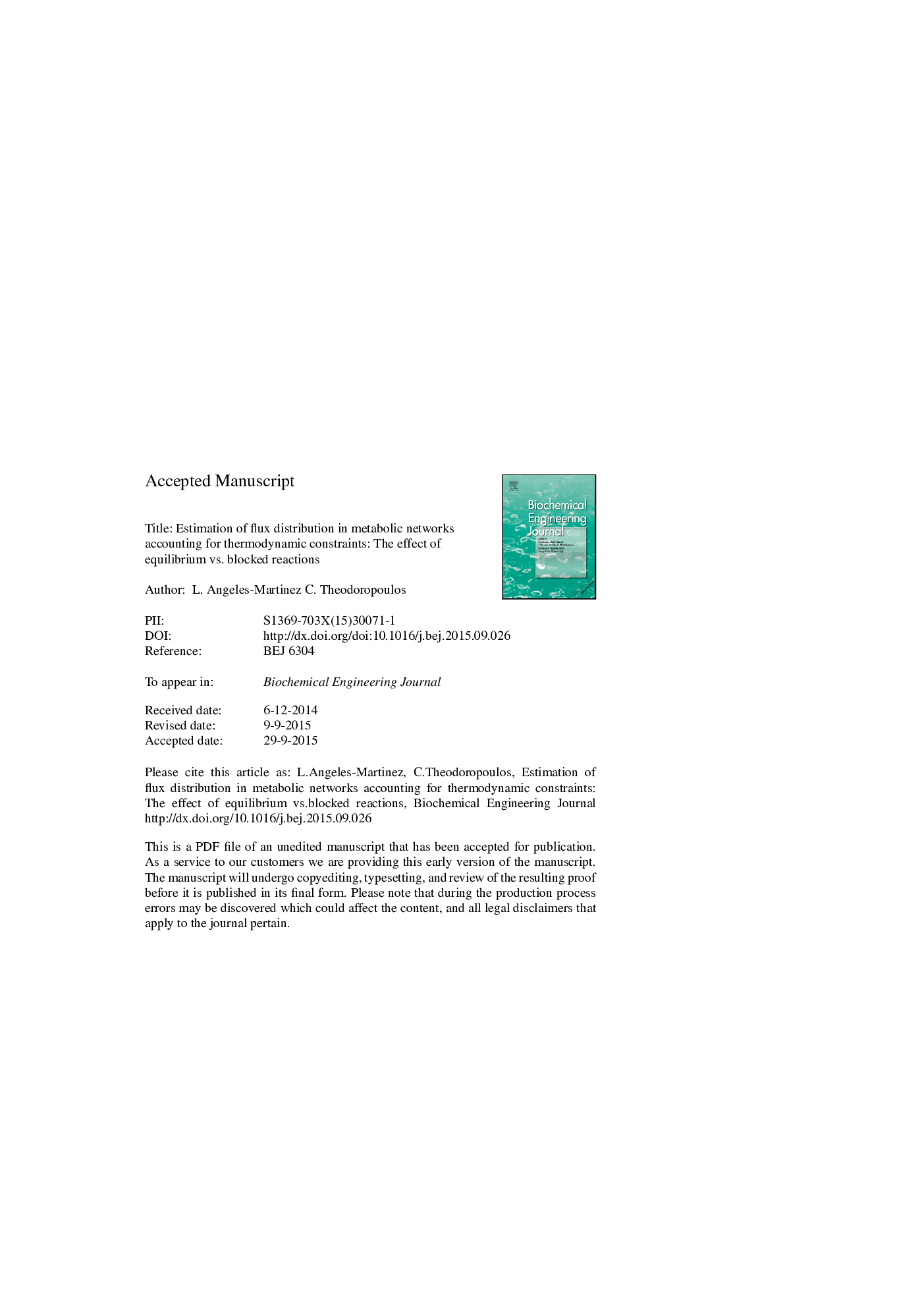| Article ID | Journal | Published Year | Pages | File Type |
|---|---|---|---|---|
| 10160534 | Biochemical Engineering Journal | 2016 | 33 Pages |
Abstract
Thermodynamically constrained stoichiometric-based models have been widely used for the estimation of feasible flux distributions of a metabolic network. The prediction of a zero net flux through a reaction indicates that this reaction is either blocked (the enzyme is absent) or at equilibrium (the enzyme is present but the Gibbs free energy change of the reaction is zero). The estimation of the thermodynamic equilibrium of a reaction requires the exact knowledge of environmental conditions and metabolites' concentrations. This information, however, is not always available. Here, the effect of considering that a reaction is at equilibrium instead of being blocked on the metabolic flux distribution is analysed. The central carbon metabolism of Actinobacillus succinogenes for the production of succinic acid from glycerol has been used as case study, based on results from experiments in 1.8Â L batch bioreactors. The impact of changes in ionic strength (I), temperature (T), intracellular pHc and medium pHe was also investigated, revealing that only I and T affect the prediction of flux distributions compared with those obtained at standard biological conditions when zero flux reactions are considered either as blocked or at equilibrium. In general, the range of fluxes estimated for the equilibrium case is narrower than that for the blocked case.
Keywords
LACNADPEtOHFBADCWNADPHFRDG3PDHAPFBPMALFVATPIActinobacillus succinogenesPEPOADeNOCOAEBAMDHRPEenolasePFLrPIGAPDG6PPDHPGMPYRFDPTALAXu5PR5PS7PPFKPGKOAAOxaloacetateME2F6PPGLPGI3PGAcCoAgndSuccTriose-phosphate isomeraseActPFBAREnergy balance analysisE4PACKR2PGRU5PTCFE6PGL3-phosphoglycerate kinase6-Phosphofructokinase6-phosphogluconolactonaseFUMmalic enzymeEthanolErythrose 4-phosphateAcetateAcetate kinaseAcetaldehyde dehydrogenaseacetaldehydeacetyl phosphateAcetyl-CoAAlcohol dehydrogenaseFORBioreactionsWater exchangeBioconversionFlux balance analysisFlux variability analysisTransaldolaseTransketolasedihydroxyacetone phosphateOxaloacetate decarboxylaseribose-5-phosphateRibose-5-phosphate isomeraseribulose-5-phosphatexylulose 5-phosphatesedoheptulose 7-phosphateSuccinateformateFormate dehydrogenasefructose 1,6-bisphosphatefructose-6-phosphateFructose-bisphosphate aldolasefructose-1,6-bisphosphatasePhosphatephosphoenolpyruvatephosphoenolpyruvate carboxykinasePhosphogluconate dehydrogenasephosphoglycerate mutaseFumaratefumarate reductaseFumaraseLactatelactate dehydrogenaseLDHmalateCO2 exchangeModellingmalate dehydrogenaseNADHNADnicotinamide adenine dinucleotidenicotinamide adenine dinucleotide phosphatedry cell weightPyruvatepyruvate dehydrogenase complexpyruvate formate lyasepyruvate kinasePYKcoenzyme AGlucose 6-phosphateGlucose-6-phosphate isomeraseglucose-6-phosphate dehydrogenaseGlycglycerol 3-phosphateGlycerol 3-phosphate dehydrogenaseGlycerol kinaseGlycerolglyceraldehyde 3-phosphate
Related Topics
Physical Sciences and Engineering
Chemical Engineering
Bioengineering
Authors
L. Angeles-Martinez, C. Theodoropoulos,
